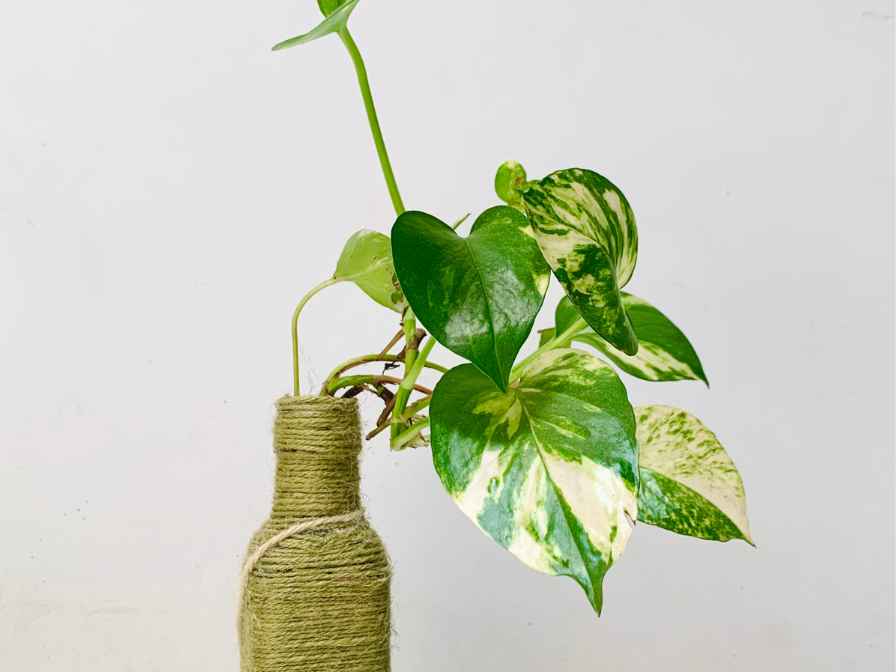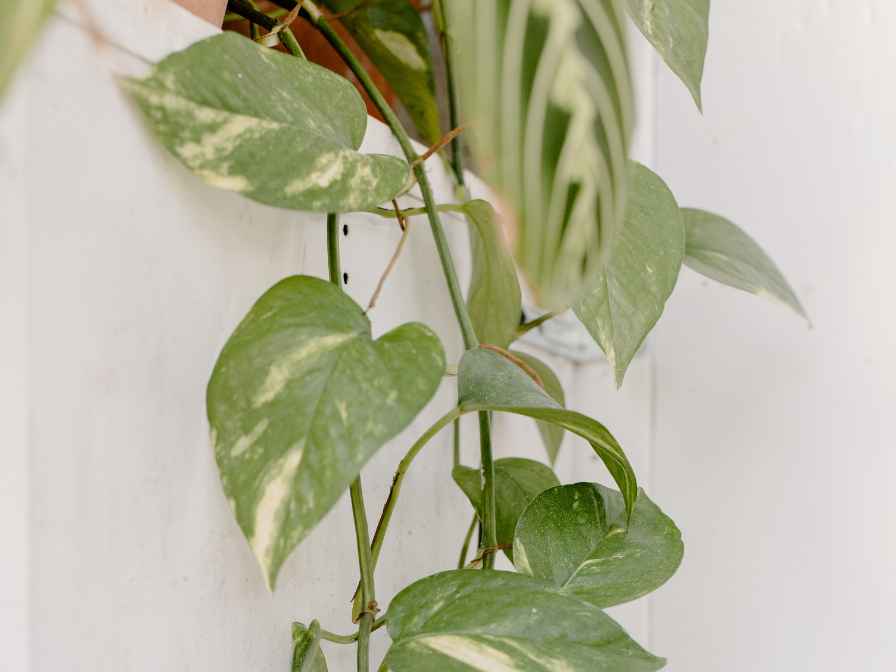Many gardeners when starting gardening they look for an indoor plant that has more than one benefit and requires little care. Pothos is one such plant. you might be wondering how to start a new Pothos plant. Well, we are going to tell you about that.

Pothos Plants
Pothos plants, also known as Epipremnum aureum or Devil’s Ivy, are popular indoor plants known for their lush foliage and easy care requirements. Their native area is Southeast Asia and is a part of the Araceae family.
Pothos plants are known for their trailing vines with heart-shaped leaves that come in various shades of green, making them a popular choice for hanging baskets or trailing down from shelves or furniture.
One of the reasons why pothos plants are so popular is their ability to thrive in a wide range of indoor environments. They can tolerate low light conditions, making them suitable for offices or rooms with limited natural light.
However, they can also tolerate brighter light conditions, but direct sunlight should be avoided as it can scorch their leaves. Pothos plants are also known for their air-purifying properties, as they can help filter and remove toxins from the air, making them an excellent choice for improving indoor air quality.
Another notable feature of pothos plants is their low-maintenance nature. They are relatively easy to care for and are suitable for both beginner and experienced plant owners. Pothos plants prefer a well-draining potting mix and should be allowed to dry out slightly between watering.
They can tolerate periods of drought, but overwatering can lead to root rot. Pothos plants can also be propagated easily through stem cuttings, allowing for easy expansion of your plant collection or sharing with friends and family.
Benefits of Planting Pothos Plants
There are several benefits to planting pothos plants, also known as Devil’s Ivy, indoors or in your garden. Here are some of the key benefits:
Air Purification
Pothos plants are known for their excellent air-purifying properties. They can filter and remove toxins such as formaldehyde, benzene, and xylene from the air, which are commonly found in indoor environments due to various household products and materials.
To improve the air quality indoors, it is quite a cost-effective method to plant pothos.
Low-maintenance
Pothos plants are appropriate for both novice and expert plant owners and require little maintenance. They are suited to many interior contexts due to their wide range of light tolerance, including low light.
Moreover, they can withstand dry spells, and they don’t need to be watered frequently. Pothos plants are a low-maintenance plant option since they can flourish in a range of potting solutions and are largely resistant to pests and diseases.
Aesthetic Appeal
Pothos plants are known for their trailing vines and heart-shaped leaves, which can add a touch of natural beauty and greenery to any space. They can be grown in hanging baskets or allowed to trail down from shelves or furniture, creating a visually appealing display.
Pothos plants come in various shades of green, ranging from dark green to variegated with yellow or white, adding visual interest to any room or garden setting.
Versatility
Pothos plants are versatile in their use and placement. They can be grown as indoor plants in homes, offices, or other indoor environments, or they can be planted outdoors in gardens or as ground cover.
Pothos plants are suitable for various settings, including living rooms, bedrooms, bathrooms, and kitchens, as well as offices, schools, or other public spaces, making them a versatile choice for adding natural beauty to different environments.
How to Start a New Pothos Plant

Here are the basic steps to plant the new pothos plant. this process is quite easy and will be effective if followed as directed. Here are all of these steps;
Gathering the Materials
You’ll need the following materials:
– Healthy pothos plant with established vines
– Clean, sharp scissors or pruning shears
– A small container or glass with water
Optional – rooting hormone (powder or liquid)
Choose a Stem Cutting
Select a healthy vine from the pothos plant to use as a cutting. Look for a vine that has at least two or three leaves, and is not too woody or too young. The ideal cutting is typically around 4-6 inches in length.
Prepare the Cutting
Using clean, sharp scissors or pruning shears, make a clean cut just below a node, which is the point where leaves emerge from the stem. Nodes are important because this is where new roots will form. Remove any leaves from the bottom of one or two nodes to expose the nodes for rooting.
(Optional) – Apply Rooting Hormone
If desired, get the rooting hormone and dip the end of the stem in it which can promote root development. This step is optional, but it can increase the success rate of rooting.
Place the Cutting in the Water
Fill a small container or glass with water, and place the cut end of the stem into the water, with the nodes submerged. The leaves should be above the water level. Avoid direct sunlight and place the container in indirect bright light.
Change Water Regularly
Change the water in the container every 1-2 weeks, or whenever it becomes cloudy or dirty. Use room temperature water, and make sure the nodes remain submerged in water.
Wait for Root Development
Be patient and wait for roots to develop, which usually takes a few weeks to a couple of months, depending on the environmental conditions and the health of the cutting. Once the roots are at least 1-2 inches long, your cutting is ready to be potted.
Potting the Cutting
Prepare a small pot with a well-draining potting mix. Carefully remove the cutting from the water, and gently plant it in the potting mix, with the nodes covered by the soil. Water the cutting thoroughly, and place it in a location with bright, indirect light. Keep the soil slightly moist, but avoid overwatering.
Taking Care of Pothos Plants
Light & Water
While they may survive low light levels, pothos plants prefer bright, indirect light. They should not be placed in direct sunlight as this might result in leaf burn.
Pothos plants like soil that is just damp enough, but not waterlogged. Between waterings, let the top inch of the soil dry up, and then water deeply, letting the extra water run out of the pot.
Humidity & Temperature
Pothos plants can tolerate average room humidity, but they do appreciate slightly higher humidity levels. You can increase humidity around your pothos plant by misting the leaves with water.
Pothos plants prefer temperatures between 65-85°F. Avoid placing them in areas with extreme temperature fluctuations.
Fertilizer
Pothos plants benefit from regular fertilization during the growing season (spring to summer). You can use a balanced houseplant fertilizer according to package instructions, usually diluted to half strength, and apply it every 2-4 weeks. Avoid over-fertilizing, as this can cause leaf burn or fertilizer buildup in the soil.
Pruning
Pothos plants can be pruned to maintain their shape and promote bushier growth. You can pinch off the tips of the vines to encourage branching or trim back any leggy or yellowing leaves. Pruning can also help control the size of the plant if it becomes too large for its space.
Potting
Pothos plants generally do well in a well-draining potting mix. You can use a standard indoor potting mix or create your own mix with a combination of potting soil, perlite, and peat moss. Re pot your pothos plant into a slightly larger pot when it becomes root-bound, usually every 1-2 years.
Pest Control
These plants are known for pest resistance, but they can occasionally be infested with common houseplant pests such as mealybugs, scale, or spider mites. If you notice any signs of pest infestation, promptly treat your plant with an appropriate insecticidal soap or neem oil, following the instructions on the product label.
In a nutshell, the pothos plant is a great choice for indoor plant settings. It adds ornamental value to the space along with having air purifying benefits. Moreover, it is quite easy to plant and take care of.
FAQs
How do you know when pothos are ready to plant?
When the roots start appearing and growing. It is all about timing. Pothos take 4 to 6 weeks to develop roots in the water. Once roots have grown you can start preparing the soil for planting the pothos plant.
How do you take care of the newly propagated pothos?
Just make sure you have planted the pothos plant in the right soil mix. Also, make sure that the plant gets enough water to keep up with the moisture. Don’t place the pothos plant in direct sunlight.
Will pothos regrow from cuttings?
Yes. It is the common method that is practiced to propagate and plant the pothos plants. You just need to get the right cutting and place it in the water. It will grow its roots after some time. After that, you can plant it in the pot.

